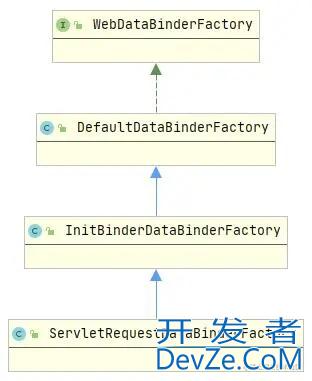目录
- 前言
- 一. @InitBinder注解使用说明
- 二. 实现自定义Editor
- 三. WebDataBinder初始化原理解析
- 四. @InitBinder注解修饰的方法的加载
- 总结
前言
由@InitBinder注解修饰的方法用于初始化WebDataBinder对象,能够实现:从request获取到handler方法中由@RequestParam注解或@PathVariable注解修饰的参数后,假如获取到的参数类型与handler方法上的参数类型不匹配,此时可以使用初始化好的WebDataBinder对获取到的参数进行类型处理。
一个经典的例子就是handler方法上的参数类型为Date,而从request中获取到的参数类型是字符串,SpringMVC在默认情况下无法实现字符串转Date,此时可以在由@InitBinder注解修饰的方法中为WebDataBinder对象注册CustomDateEditor,从而使得WebDataBinder能将从request中获取到的字符串再转换为Date对象。
通常,如果在@ControllerAdvice注解修饰的类中使用@InitBinder注解,此时@InitBinder注解修饰的方法所做的事情全局生效(前提是@ControllerAdvice注解没有设置basePackages字段);如果在@Controller注解修饰的类中使用@InitBinder注解,此时@InitBinder注解修饰的方法所做的事情仅对当前Controller生效。本篇文章将结合简单例子,对@InitBinder注解的使用,原理进行学习。
SpringBoot版本:2.4.1
一. @InitBinder注解使用说明
以前言中提到的字符串转Date为例,对@InitBinder的使用进行说明。
@RestController
public class DateController {
private static final String SUCCESS = "success";
private static final String FAILED = "failed";
private final List<Date> dates = new ArrayList<>();
@RequestMapping(value = "/api/v1/date/add", method = RequestMethod.GET)
public ResponseEntity<String> addDate(@Re开发者_开发入门questParam("date") Date date) {
ResponseEntity<String> response;
try {
dates.add(date);
response = new ResponseEntity<>(SUCCESS, HttpStatus.OK);
} catch (Exception e) {
e.printStackTrace();
response = new ResponseEntity<>(FAILED, HttpStatus.INTERNAL_SERVER_ERROR);
}
return response;
}
}
上面写好了一个简单的Controller,用于获取Date并存储。然后在单元测试中使用TestRestTemplate模拟客户端向服务端发起请求,程序如下。
@Extendwith(SpringExtension.class)
@SpringBootTest(webEnvironment = SpringBootTest.WebEnvironment.RANDOM_PORT)
class DateControllerTest {
@Autowired
private TestRestTemplate restTemplate;
@Test
void 测试Date字符串转换为Date对象() {
ResponseEntity<String> response = restTemplate
.getForEntity("/api/v1/date/add?date=20200620", String.class);
assertThat(response.getStatusCodeValue(), is(HttpStatus.OK.value()));
}
}
由于此时并没有使用@InitBinder注解修饰的方法向WebDataBinder注册CustomDateEditor对象,运行测试程序时断言会无法通过,报错会包含如下信息。
Failed to convert value of type 'Java.lang.String' to required type 'java.util.Date'
由于无法将字符串转换为Date,导致了参数类型不匹配的异常。
下面使用@ControllerAdvice注解和@InitBinder注解为WebDataBinder添加CustomDateEditor对象,使SpringMVC框架为我们实现字符串转Date。
@ControllerAdvice
public class GlobalControllerAdvice {
@InitBinder
public void setDateEditor(WebDataBinder binder) {
binder.registerCustomEditor(Date.class,
new CustomDateEditor(new SimpleDateFormat("yyyyMMdd"), false));
}
}
此时再执行测试程序,断言通过。
小节:由@InitBinder注解修饰的方法返回值类型必须为void,入参必须为WebDataBinder对象实例。如果在@Controller注解修饰的类中使用@InitBinder注解则配置仅对当前类生效,如果在@ControllerAdvice注解修饰的类中使用@InitBinder注解则配置全局生效。
二. 实现自定义Editor
现在假如需要将日期字符串转换为LocalDate,但是SpringMVC框架并没有提供类似于CustomDateEditor这样的Editor时,可以通过继承PropertyEditorSupport类来实现自定义Editor。首先看如下的一个Controller。
@RestController
public class LocalDateController {
private static final String SUCCESS = "success";
private static final String FAILED = "failed";
private final List<LocalDate> localDates = new ArrayList<>();
@RequestMapping(value = "/api/v1/localdate/add", method = RequestMethod.GET)
public ResponseEntity<String> addLocalDate(@RequestParam("localdate") LocalDate localDate) {
ResponseEntity<String> response;
try {
localDates.addphp(localDate);
response = new ResponseEntity<>(SUCCESS, HttpStatus.OK);
} catch (Exception e) {
e.printStackTrace();
response = new ResponseEntity<>(FAILED, HttpStatus.INTERNAL_SERVER_ERROR);
}
return response;
}
}
同样的在单元测试中使用TestRestTemplate模拟客户端向服务端发起请求。
@ExtendWith(SpringExtension.class)
@SpringBootTest(webEnvironment = SpringBootTest.WebEnvironment.RANDOM_PORT)
class LocalDateControllerTest {
@Autowired
private TestRestTemplate restTemplate;
@Test
void 测试LocalDate字符串转换为LocalDate对象() {
ResponseEntity<String> response = restTemplate
.getForEntity("/api/v1/localdate/add?localdate=20200620", String.class);
assertThat(response.getStatusCodeValue(), is(HttpStatus.OK.value()));
}
}
此时直接执行测试程序断言会不通过,会报错类型转换异常。现在实现一个自定义的Editor。
public class CustomLocalDateEditor extends PropertyEditorSupport {
private static final DateTimeFormatter dateTimeFormatter
= DateTimeFormatter.ofPattern("yyyyMMdd");
@Override
public void setAsText(String text) throws IllegalArgumentException {
if (StringUtils.isEmpty(text)) {
throw new IllegalArgumentException("Can not convert null.");
}
LocalDate result;
try {
result = LocalDate.from(dateTimeFormatter.parse(text));
编程客栈 setValue(result);
} catch (Exception e) {
throw new IllegalArgumentException("CustomDtoEditor convert failed.", e);
}
}
}
CustomLocalDateEditor是自定义的Editor,最简单的情况下,通过继承PropertyEditorSupport并重写setAsText() 方法可以实现一个自定义Editor。通常,自定义的转换逻辑在setAsText() 方法中实现,并将转换后的值通过调用父类PropertyEditorSupport的setValue() 方法完成设置。
同样的,使用@ControllerAdvice注解和@InitBinder注解为WebDataBinder添加CustomLocalDateEditor对象。
@ControllerAdvice
public class GlobalControllerAdvice {
@InitBinder
public void set编程客栈LocalDateEditor(WebDataBinder binder) {
binder.registerCustomEditor(LocalDate.class,
new CustomLocalDateEditor());
}
}
此时再执行测试程序,断言全部通过。
小节:通过继承PropertyEditorSupport类并重写setAsText()方法可以实现一个自定义Editor。
三. WebDataBinder初始化原理解析
已经知道,由@InitBinder注解修饰的方法用于初始化WebDataBinder,并且在详解SpringMVC-RequestMappingHandlerAdapter这篇文章中提到:从request获取到handler方法中由@RequestParam注解或@PathVariable注解修饰的参数后,便会使用WebDataBinderFactory工厂完成对WebDataBinder的初始化。下面看一下具体的实现。
AbstractNamedValueMethodArgumentResolver#resolveArgument部分源码如下所示。
public final Object resolveArgument(MethodParameter parameter, @Nullable ModelAndViewContainer mavContainer,
NativeWebRequest webRequest, @Nullable WebDataBinderFactory binderFactory) throws Exception {
// ...
// 获取到参数
Object arg = resolveName(resolvedName.toString(), nestedParameter, webRequest);
// ...
if (binderFactory != null) {
// 初始化WebDataBinder
WebDataBinder binder = binderFactory.createBinder(webRequest, null, namedValueInfo.name);
try {
arg = binder.convertIfNecessary(arg, parameter.getParameterType(), parameter);
}
catch (ConversionNotSupportedException ex) {
throw new MethodArgumentConversionNotSupportedException(arg, ex.getRequiredType(),
namedValueInfo.name, parameter, ex.getCause());
}
catch (TypeMismatchException ex) {
throw new MethodArgumentTypeMismatchException(arg, ex.getRequiredType(),
namedValueInfo.name, parameter, ex.getCause());
}
if (arg == null && namedValueInfo.defaultValue == null &&
namedValueInfo.required && !nestedParameter.isOptional()) {
handleMissingValue(namedValueInfo.name, nestedParameter, webRequest);
}
}
handleResolvedValue(arg, namedValueInfo.name, parameter, mavContainer, webRequest);
return arg;
}
实际上,上面方法中的binderFactory是ServletRequestDataBinderFactory工厂类,该类的类图如下所示。

createBinder() 是由接口WebDataBinderFactory声明的方法,ServletRequestDataBinderFactory的父类DefaultDataBinderFactory对其进行了实现,实现如下。
public final WebDataBinder createBinder(
NativeWebRequest webRequest, @Nullable Object target, String objectName) throws Exception {
// 创建WebDataBinder实例
WebDataBinder dataBinder = createBinderInstance(target, objectName, webRequest);
if (this.initializer != null) {
// 调用WebBindingInitializer对WebDataBinder进行初始化
this.initializer.initBinder(dataBinder, webRequest);
}
// 调用由@InitBinder注解修饰的方法对WebDataBinder进行初始化
initBinder(dataBinder, webRequest);
return dataBinder;
}
initBinder() 是DefaultDataBinderFactory的一个模板方法,InitBinderDataBinderFactory对其进行了重写,如下所示。
public void initBinder(WebDataBinder dataBinder, NativeWebRequest request) throws Exception {
for (InvocableHandlerMethod binderMethod : this.binderMethods) {
if (isBinderMethodApplicable(binderMethod, dataBinder)) {
// 执行由@InitBinder注解修饰的方法,完成对WebDataBinder的初始化
Object returnValue = binderMethod.invokeForRequest(request, null, dataBinder);
if (returnValue != null) {
throw new IllegalStateException(
"@InitBinder methods must not return a value (should be void): " + binderMethod);
}
}
}
}
如上,initBinder() 方法中会遍历加载的所有由@InitBinder注解修饰的方法并执行,从而完成对WebDataBinder的初始化。
小节:WebDataBinder的初始化是由WebDataBinderFactory先创建WebDataBinder实例,然后遍历WebDataBinderFactory加载好的由@InitBinder注解修饰的方法并执行,以完成WebDataBinder的初始化。
四. @InitBinder注解修饰的方法的加载
由第三小节可知,WebDataBinder的初始化是由WebDataBinderFactory先创建WebDataBinder实例,然后遍历WebDataBinderFactory加载好的由@InitBinder注解修饰的方法并执行,以完成WebDataBinder的初始化。本小节将学习WebDataBinderFactory如何加载由@InitBinder注解修饰的方法。
WebDataBinderFactory的获取是发生在RequestMappingHandlerAdapter的invokeHandlerMethod() 方法中,在该方法中是通过调用getDataBinderFactory() 方法获取WebDataBinderFactory。下面看一下其实现。
RequestMappingHandlerAdapter#getDataBinderFactory源码如下所示。
private WebDataBinderFactory getDataBinderFactory(HandlerMethod handlerMethod) throws Exception {
// 获取handler的Class对象
Class<?> handlerType = handlerMethod.getBeanType();
// 从initBinderCache中根据handler的Class对象获取缓存的initBinder方法集合
Set<Method> methods = this.initBinderCache.get(handlerType);
// 从initBinderCache没有获取到initBinder方法集合,则执行MethodIntrospector.selectMethods()方法获取handler的initBinder方法集合,并缓存到initBinderCache中
if (methods == null) {
methods = MethodIntrospector.selectMethods(handlerType, INIT_BINDER_METHODS);
this.initBinderCache.put(handlerType, methods);
}
// initBinderMethods是WebDataBinderFactory需要加载的initBinder方法集合
List<InvocableHandlerMethod> initBinderMethods = new ArrayList<>();
// initBinderAdviceCache中存储的是全局生效的initBinder方法
this.initBinderAdviceCache.forEach((controllerAdviceBean, methodSet) -> {
// 如果ControllerAdviceBean有限制生效范围,则判断其是否对当前handler生效
if (controllerAdviceBean.isApplicableToBeanType(handlerType)) {
Object bean = controllerAdviceBean.resolveBean();
// 如果对当前handler生效,则ControllerAdviceBean的所有initBinder方法均需要添加到initBinderMethods中
for (Method method : methodSet) {
initBinderMethods.add(createInitBinderMethod(bean, method));
}
}
});
// 将handler的所有initBinder方法添加到initBinderMethods中
for (Method method : methods) {
Object bean = handlerMethod.getBean();
initBinderMethods.add(createInitBinderMethod(bean, method));
}
// 创建WebDataBinderFactory,并同时加载initBinderMethods中的所有initBinder方法
return createDataBinderFactory(initBinderMethods);
}
上面的方法中使用到了两个缓存,initBinderCache和initBinderAdviceCache,表示如下。
private final Map<Class<?>, Set<Method>> initBinderCache = new ConcurrentHashMap<>(64); private final Map<ControllerAdviceBean, Set<Method>> initBinderAdviceCache = new LinkedHashMap<>();
其中initBinderCache的key是handler的Class对象,value是handler的initBinder方法集合,initBinderCache一开始是没有值的,当需要获取handler对应的initBinder方法集合时,会先从initBinderCache中获取,如果获取不到才会调用MethodIntrospector#selectMethods方法获取,然后再将获取到的handler对应的initBinder方法集合缓存到initBinderCache中。
initBinderAdviceCache的key是ControllerAdviceBean,value是ControllerAdviceBean的initBinder方法集合,initBinderAdviceCache的值是在RequestMappingHandlerAdapter初始化时调用的afterPropertiesSet() 方法中完成加载的,具体的逻辑在详解SpringMVC-RequestMappingHandlerAdapter有详细说明。
因此WebDataBinderFactory中的initBinder方法由两部分组成,一部分是写在当前handler中的initBinder方法(这解释了为什么写在handler中的initBinder方法仅对当前handler生效),另外一部分是写在由@ControllerAdvice注解修饰的类中的initBinder方法,所有的这些initBinder方法均会对WebDataBinderFactory创建的WebDataBinder对象进行初始化。
最后,看一下createDataBinderFactory() 的实现。
RequestMappingHandlerAdapter#createDataBinderFactory
protected InitBinderDataBinderFactory createDataBinderFactory(List<InvocableHandlerMethod> binderMethods)
throws Exception {
return new ServletRequestDataBinderFactory(binderMethods, getWebBindingInitializer());
}
ServletRequestDataBinderFactory#ServletRequestDataBinderFactory
public ServletRequestDataBinderFactory(@Nullable List<InvocableHandlerMethod> binderMethods,
@Nullable WebBindingInitializer initializer) {
super(binderMethods, initializer);
}
InitBinderDataBinderFactory#InitBinderDataBinderFactory
public InitBinderDataBinderFactory(@Nullable List<InvocabandroidleHandlerMethod> binderMethods,
@Nullable WebBindingInitializer initializer) {
super(initializer);
this.binderMethods = (binderMethods != null ? binderMethods : Collections.emptyList());
}
可以发现,最终创建的WebDataBinderFactory实际上是ServletRequestDataBinderFactory,并且在执行ServletRequestDataBinderFactory的构造函数时,会调用其父类InitBinderDataBinderFactory的构造函数,在这个构造函数中,会将之前获取到的生效范围内的initBinder方法赋值给InitBinderDataBinderFactory的binderMethods变量,最终完成了initBinder方法的加载。
小节:由@InitBinder注解修饰的方法的加载发生在创建WebDataBinderFactory时,在创建WebDataBinderFactory之前,会先获取对当前handler生效的initBinder方法集合,然后在创建WebDataBinder编程客栈Factory的构造函数中将获取到的initBinder方法集合加载到WebDataBinderFactory中。
总结
由@InitBinder注解修饰的方法用于初始化WebDataBinder,从而实现请求参数的类型转换适配,例如日期字符串转换为日期Date类型,同时可以通过继承PropertyEditorSupport类来实现自定义Editor,从而增加可以转换适配的类型种类。
以上就是Spring @InitBinder注解使用及原理详解的详细内容,更多关于Spring @InitBinder注解原理的资料请关注我们其它相关文章!









 加载中,请稍侯......
加载中,请稍侯......
精彩评论